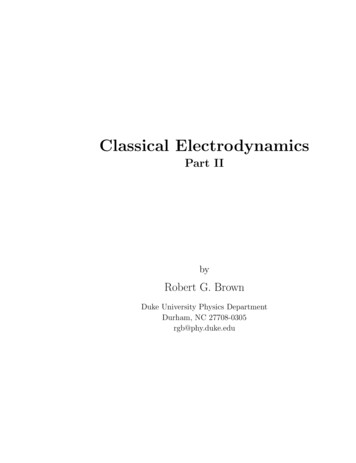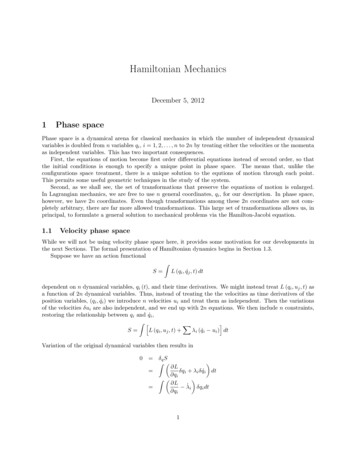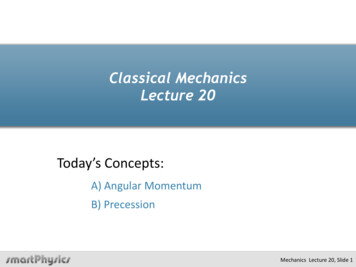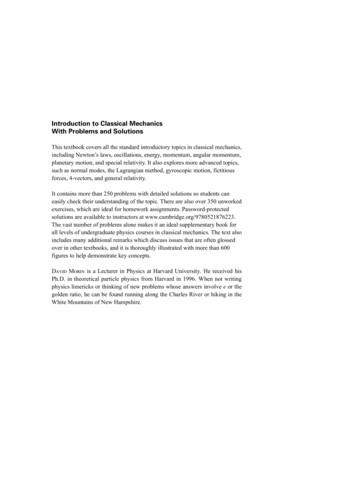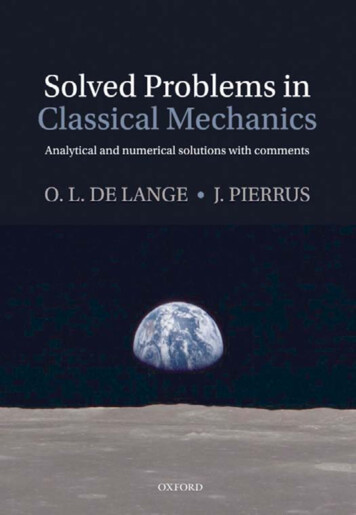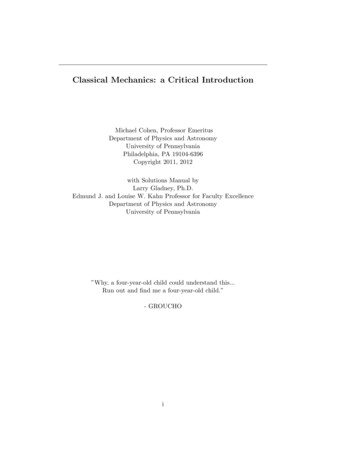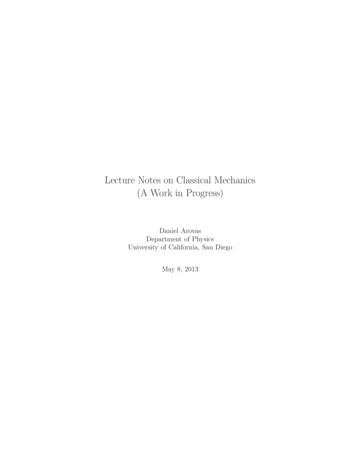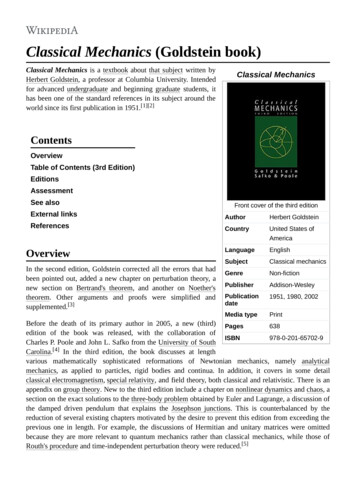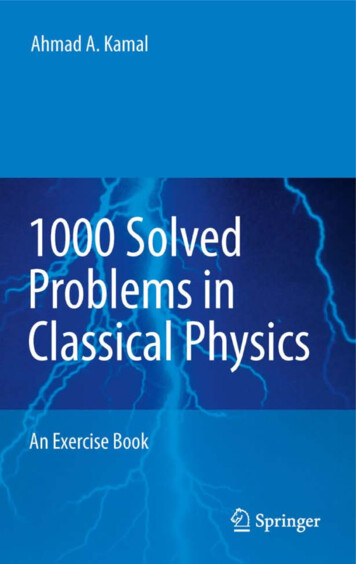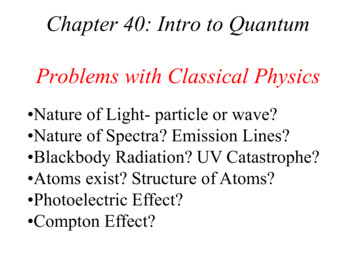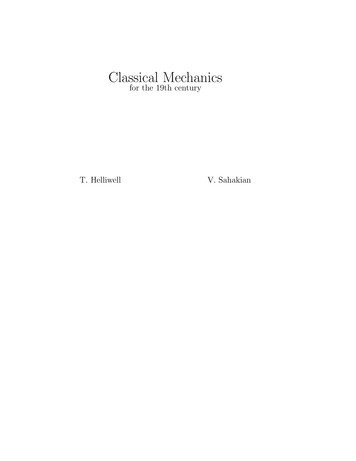
Transcription
Classical Mechanicsfor the 19th centuryT. HelliwellV. Sahakian
Contents1 Newtonian particle mechanics11.1 Inertial frames and the Galilean transformation . . . . . . . . 11.2 Newton’s laws of motion . . . . . . . . . . . . . . . . . . . . . 4Example 1-1: A bacterium with a viscous retarding forceExample 1-2: A linearly damped oscillator1.3 Systems of particles . . . . . . . . . . . . . . . . . . . . . . . . 121.4 Conservation laws . . . . . . . . . . . . . . . . . . . . . . . . . 15Example 1-3: A wrench in spaceExample 1-4: A particle moving in two dimensions with an attractivespring forceExample 1-5: A particle attached to a spring revisitedExample 1-6: Newtonian gravity and its potential energyExample 1-7: Dropping a particle in spherical gravityExample 1-8: Potential energies and turning points for positive power-lawforces1.5 Forces of nature . . . . . . . . . . . . . . . . . . . . . . . . . . 321.6 Dimensional analysis . . . . . . . . . . . . . . . . . . . . . . . 34Example 1-9: Find the rate at which molasses flows through a narrowpipe1.7 Synopsis . . . . . . . . . . . . . . . . . . . . . . . . . . . . . . 371.8 Exercises and Problems . . . . . . . . . . . . . . . . . . . . . . 382 Relativity2.1 Foundations . . . . . . . . . . . . .2.1.1 The Postulates . . . . . . .2.1.2 The Lorentz transformationExample 2-1: Rotation and rapidity2.2 Relativistic kinematics . . . . . . .i47. . . . . . . . . . . . . . . 47. . . . . . . . . . . . . . . 47. . . . . . . . . . . . . . . 49. . . . . . . . . . . . . . . 56
iiCONTENTS2.2.1 Proper time . . . . . . . . . . . . . . . .2.2.2 Four-velocity . . . . . . . . . . . . . . .Example 2-2: The transformation of ordinary velocity2.3 Relativistic dynamics . . . . . . . . . . . . . . .2.3.1 Four-momentum . . . . . . . . . . . . .Example 2-3: Relativistic dispersion relationExample 2-4: Decay into two particles2.3.2 Four-force . . . . . . . . . . . . . . . . .2.3.3 Dynamics in practice . . . . . . . . . . .Example 2-5: Uniformly accelerated motionExample 2-6: The Doppler e ect2.3.4 Minkowski diagrams . . . . . . . . . . .Example 2-7: Time dilationExample 2-8: Length contractionExample 2-9: The twin paradox2.4 Exercises and Problems . . . . . . . . . . . . . .3 The Variational Principle3.1 Fermat’s principle . . . . . . . . . . . .3.2 The calculus of variations . . . . . . .3.3 Geodesics . . . . . . . . . . . . . . . .Example 3-1: Geodesics on a planeExample 3-2: Geodesics on a sphere3.4 Brachistochrone . . . . . . . . . . . . .Example 3-3: Fermat again3.5 Several Dependent Variables . . . . . .Example 3-4: Geodesics in three dimensions3.6 Mechanics from a variational principle3.7 Motion in a uniform gravitational field3.8 Summary . . . . . . . . . . . . . . . .3.9 Exercises and Problems . . . . . . . . . . . . . . . . 56. . . . . . . . 59. . . . . . . . 64. . . . . . . . 64. . . . . . . . 70. . . . . . . . 72. . . . . . . . 78. . . . . . . . 8899. . . . . . . . . . . . . 99. . . . . . . . . . . . . 101. . . . . . . . . . . . . 108. . . . . . . . . . . . . 113. . . . . . . . . . . . . 119.1211231271294 Lagrangian mechanics1374.1 The Lagrangian in Cartesian coordinates . . . . . . . . . . . . 1374.2 Hamilton’s principle . . . . . . . . . . . . . . . . . . . . . . . 138Example 4-1: A simple pendulumExample 4-2: A bead sliding on a vertical helixExample 4-3: Block on an inclined plane
CONTENTSiii4.3 Generalized momenta and cyclic coordinates . . . . . . . . .Example 4-4: Particle on a tabletop, with a central forceExample 4-5: The spherical pendulum4.4 The Hamiltonian . . . . . . . . . . . . . . . . . . . . . . . .Example 4-6: Bead on a rotating parabolic wire4.5 Systems of particles . . . . . . . . . . . . . . . . . . . . . . .Example 4-7: Two interacting particlesExample 4-8: Pulleys everywhereExample 4-9: A block on a movable inclined plane4.6 Small oscillations about equilibrium . . . . . . . . . . . . . .Example 4-10: Particle on a tabletop with a central spring forceExample 4-11: Oscillations of a bead on a rotating parabolic wire4.7 Relativistic generalization . . . . . . . . . . . . . . . . . . .4.8 Summary . . . . . . . . . . . . . . . . . . . . . . . . . . . .4.9 Appendix A: When and why is H 6 T U ? . . . . . . . . .4.10 Exercises and Problems . . . . . . . . . . . . . . . . . . . . .5 Symmetries and Conservation LawsExample 5-1: A simple example5.1 Infinitesimal transformations . . . . . . . . . . . . . . .5.1.1 Direct transformations . . . . . . . . . . . . . .5.1.2 Indirect transformations . . . . . . . . . . . . .5.1.3 Combined transformations . . . . . . . . . . . .Example 5-2: TranslationsExample 5-3: RotationsExample 5-4: Lorentz transformations5.2 Symmetry . . . . . . . . . . . . . . . . . . . . . . . . .5.2.1 Noether’s theorem . . . . . . . . . . . . . . . .Example 5-5: Space translations and momentumExample 5-6: Time translation and energyExample 5-7: Rotations and angular momentumExample 5-8: Lorentz and Galilean BoostsExample 5-9: Sculpting Lagrangians from symmetryExample 5-10: Generalized momenta and cyclic coordinates5.2.2 Some comments on symmetries . . . . . . . . .5.3 Exercises and Problems . . . . . . . . . . . . . . . . . . 146. 154. 160. 170.174175178180189.191191192193. . . . 195. . . . 196. . . . 209. . . . 210
ivCONTENTS6 Gravitation and Central-force motion6.1 Central forces . . . . . . . . . . . . . . . . . . . . .6.2 The two-body problem . . . . . . . . . . . . . . . .6.3 The e ective potential energy . . . . . . . . . . . .6.3.1 Radial motion for the central-spring problem6.3.2 Radial motion in central gravity . . . . . . .6.4 Bertrand’s Theorem . . . . . . . . . . . . . . . . .6.5 The shape of central-force orbits . . . . . . . . . . .6.5.1 Central spring-force orbits . . . . . . . . . .6.5.2 The shape of gravitational orbits . . . . . .Example 6-1: Orbital geometry and orbital physics6.6 Orbital dynamics . . . . . . . . . . . . . . . . . . .6.6.1 Kepler’s second law . . . . . . . . . . . . . .6.6.2 Kepler’s third law . . . . . . . . . . . . . . .Example 6-2: Halley’s Comet6.6.3 Minimum-energy transfer orbits . . . . . . .Example 6-3: A trip to MarsExample 6-4: Gravitational assists6.7 Relativistic gravitation . . . . . . . . . . . . . . . .Example 6-5: The precession of Mercury’s perihelion6.8 Exercises and Problems . . . . . . . . . . . . . . . .213. 213. 216. 219. 220. 221. 223. 223. 224. 225. . . . . . 232. . . . . . 233. . . . . . 235. . . . . . 237. . . . . . 243. . . . . . 2557 Electromagnetism2657.1 The Lorentz force law . . . . . . . . . . . . . . . . . . . . . . . 2657.2 Contact forces . . . . . . . . . . . . . . . . . . . . . . . . . . . 2658 Systems of particles2678.1 Newtonian mechanics of a system . . . . . . . . . . . . . . . . 2678.2 Lagrangians for systems of particles . . . . . . . . . . . . . . . 2748.3 Exercises and Problems . . . . . . . . . . . . . . . . . . . . . . 2769 Hamiltonian formulation9.1 Legendre transformations . . . . . . . . . .9.2 Hamilton’s equations . . . . . . . . . . . .9.3 Phase space and canonical transformations9.3.1 Louiville’s theorem . . . . . . . . .9.3.2 Heisenberg formulation of Quantum. . . . . . . . . . . . . . . . . . . . . . . . .Mechanics .279. 279. 279. 279. 279. 279
CONTENTSv10 Accelerating frames10.1 Linearly accelerating frames . . . . . . . . . . . . . .Example 10-1: Pendulum in an accelerating spaceship10.2 Rotating frames . . . . . . . . . . . . . . . . . . . . .Example 10-2: Throwing a ball in a rotating space colonyExample 10-3: Polar orbits around the Earth10.3 Pseudoforces in rotating frames . . . . . . . . . . . .Example 10-4: Rotating space colonies revisited10.4 Pseudoforces on Earth . . . . . . . . . . . . . . . . .10.4.1 Centrifugal pseudoforces on Earth . . . . . . .10.4.2 Coriolis pseudoforces on Earth . . . . . . . . .Example 10-5: Coriolis pseudoforces in airflowExample 10-6: Foucault’s pendulum10.5 Spacecraft rendezvous and docking . . . . . . . . . .Example 10-7: Rendezvous with the space station?Example 10-8: Losing a wrench?10.6 Exercises and Problems . . . . . . . . . . . . . . . . .281. . . . . 281. . . . . 285. . . . . 289. . . . . 294. . . . . 295. . . . . 296. . . . . 302. . . . . 31111 Rigid Body Dynamics12 From classical to quantum and back12.1 Particles and paths . . . . . . . . .12.1.1 Double-slit experiments . .12.1.2 Feynman sum-over-paths . .12.1.3 Two-slit interference . . . .12.1.4 No barriers at all . . . . . .12.1.5 How classical in the path? .12.1.6 Motion with forces . . . . .12.2 Summary . . . . . . . . . . . . . .12.3 Double-slit experiments . . . . . . .12.4 Feynman sum-over-paths . . . . . .12.5 Two-slit interference . . . . . . . .12.6 No barriers at all . . . . . . . . . .12.7 How classical in the path? . . . . .12.8 Motion with forces . . . . . . . . .12.9 Why Hamilton’s principle? . . . . .321.323. 324. 324. 328. 331. 337. 342. 343. 344. 345. 348. 351. 357. 362. 363. 364
viCONTENTS
List of Figures1.11.21.3Various inertial frames in space. If one of these frames isinertial, any other frame moving at constant velocity relativeto it is also inertial. . . . . . . . . . . . . . . . . . . . . . . . .2Two inertial frames, O and O0 , moving relative to one anotheralong their mutual x axes. . . . . . . . . . . . . . . . . . . . .3A bacterium in a fluid. What is its motion if it begins withvelocity v0 and then stops swimming? . . . . . . . . . . . . . .81.4Motion of an oscillator if it is (a) overdamped, (b) underdamped, or (c) critically damped, for the special case wherethe oscillator is released from rest (v0 0) at some position x0 . 111.5A system of particles, with each particle identified by a position vector r . . . . . . . . . . . . . . . . . . . . . . . . . . . . 131.6A collection of particles, each with a position vector ri from afixed origin. The center of mass RCM is shown, and also theposition vector r0i of the ith particle measured from the centerof mass. . . . . . . . . . . . . . . . . . . . . . . . . . . . . . . 141.7The position vector for a particle. Angular momentum is always defined with respect to a chosen point from where theposition vector originates. . . . . . . . . . . . . . . . . . . . . 171.8A two-dimensional elliptical orbit of a ball subject to a Hooke’slaw spring force, with one end of the spring fixed at the origin. 201.9The work done by a force on a particle is its line integral alongthe path traced by the particle. . . . . . . . . . . . . . . . . . 221.10 Newtonian gravity pulling a probe mass m towards a sourcemass M . . . . . . . . . . . . . . . . . . . . . . . . . . . . . . . 27vii
viiiLIST OF FIGURES1.11 Potential energy functions for selected positive powers n. Apossible energy E is drawn as a horizontal line, since E isconstant. The di erence between E and U (x) at any point isthe value of the kinetic energy T . The kinetic energy is zero atthe “turning points”, where the E line intersects U (x). Notethat for n 1 there are two turning points for E 0, but forn 2 there is only a single turning point. . . . . . . . . . . . . 30Inertial frames O and O0 . . . . . . . . . . . . . . . . . . . .Graph of the factor as a function of the relative velocity .Note that 1 for nonrelativistic particles, and ! 1 as! 1. . . . . . . . . . . . . . . . . . . . . . . . . . . . . . .2.3 The velocity v x as a function of v 0 x for fixed relative framevelocity V 0.5c. . . . . . . . . . . . . . . . . . . . . . . . .2.4 A particle of mass m0 decays into two particles with massesm1 and m2 . Both energy and momentum are conserved in thedecay, but mass is not conserved in relativistic physics. Thatis, m0 6 m1 m2 . . . . . . . . . . . . . . . . . . . . . . . . .2.5 Plots of relativistic constant-acceleration motion. (a) showsv x (t), demonstrating that v x (t) ! c as t ! 1, i.e. the speedof light is a speed limit in Nature. The dashed line showsthe incorrect Newtonian prediction. (b) shows the hyperbolictrajectory of the particle on a c t-x graph. Once again thedashed trajectory is the Newtonian prediction. . . . . . . . .2.6 Observer O0 shooting a laser towards observer O while movingtowards O. . . . . . . . . . . . . . . . . . . . . . . . . . . . .2.7 A point on a Minkowski diagram represents an event. A particle’s trajectory appears as a curve with a slope that exceedsunity everywhere. . . . . . . . . . . . . . . . . . . . . . . . .2.8 Three events on a Minkowski diagram. Events A and B aretimelike separated; A and C are lithlike separated; and B andC are spacelike separated. . . . . . . . . . . . . . . . . . . .2.9 The hyperbolic trajectory of a particle undergoing constantacceleration motion on a Minkowski diagram. . . . . . . . .2.10 The grid lines of two observers labeling the same event on aspacetime Minkowski diagram. . . . . . . . . . . . . . . . . .2.12.2. 48. 53. 63. 68. 75. 76. 78. 79. 80. 81
LIST OF FIGURESix2.11 The time dilation phenomenon. (a) Shows the scenario of aclock carried by observer O. (b) shows the case of a clockcarried by O0 . . . . . . . . . . . . . . . . . . . . . . . . . . . . 822.12 The phenomenon of length contraction. (a) Shows the scenarioof a meter stick carried by observer O’. (b) shows the case ofa stick carried by O. . . . . . . . . . . . . . . . . . . . . . . . 832.13 Minkowski diagrams of the twin paradox. (a) shows simultaneity lines according to John. (b) shows simultaneity linesaccording to Jane, except for the two dotted lines sandwichingthe accelerating segment. . . . . . . . . . . . . . . . . . . . . . 843.13.23.33.43.53.63.73.8Light traveling by the least-time path between a and b, inwhich it moves partly through air and partly through a piece ofglass. At the interface the relationship between the angle 1 inair, with index of refraction n1 , and the angle 2 in glass, withindex of refraction n2 , is n1 sin 1 n2 sin 2 , known as Snell’slaw. This phenomenon is readily verified by experiment. . . . 100A light ray from a star travels down through Earth’s atmosphere on its way to the ground. . . . . . . . . . . . . . . . . . 102A function of two variables f (x1 , x2 ) with a local minimum atpoint A, a local maximum at point B, and a saddle point at C. 103Various paths y(x) that can be used as input to the functionalI[f (x)]. We look for that special path from which an arbitrarysmall displacement y(x) leaves the functional unchanged tolinear order in y(x). Note that y(a) y(b) 0. . . . . . . 105The coordinates and ' on a sphere. . . . . . . . . . . . . . 110(a) Great circles on a sphere are geodesics; (b) Two pathsnearby the longer of the two great-circle routes of a path. . . 112Possible least-time paths for a sliding block. . . . . . . . . . . 113A cycloid. If in darkness you watch a wheel rolling along alevel surface, with a lighted bulb attached to a point on theouter rim of the wheel, the bulb will trace out the shape of acycloid. In the diagram the wheel is rolling along horizontallybeneath the surface. For xb ( /2)yb , the rail may look likethe segment from a to b1 ; for xb ( /2)yb , the segment froma to b2 would be needed. . . . . . . . . . . . . . . . . . . . . . 115
xLIST OF FIGURES3.9(a) A light ray passing through a stack of atmospheric layers;(b) The same problem visualized as a sequence of adjacentslabs of air of di erent index of refraction. . . . . . . . . . . . 1183.10 Two spaceships, one accelerating in gravity-free space (a), andthe other at rest on the ground (b). Neither observers in theaccelerating ship nor those in the ship at rest on the groundcan find out which ship they are in on the basis of any experiments carried out solely within their ship. . . . . . . . . . . . 1233.11 A laser beam travels from the bow to the stern of the accelerating ship. . . . . . . . . . . . . . . . . . . . . . . . . . . . . . 1244.14.24.34.44.54.64.74.84.94.104.11Cartesian, cylindrical, and spherical coordinates . . . . . . . .A bead sliding on a vertically-oriented helical wire . . . . . . .Block sliding down an inclined plane . . . . . . . . . . . . . .Particle moving on a tabletop . . . . . . . . . . . . . . . . . .The e ective radial potential energy for a mass m moving withan e ective potential energy Ue (p' )2 /2mr2 (1/2)kr2 forvarious values of p' , m, and k. . . . . . . . . . . . . . . . . . .Coordinates of a ball hanging on an unstretchable string . . .A sketch of the e ective potential energy Ue for a sphericalpendulum. A ball at the minimum of Ue is circling the verticalaxis passing through the point of suspension, at constant .The fact that there is a potential energy minimum at someangle 0 means that if disturbed from this value the ball willoscillate back and forth about 0 as it orbits the vertical axis.A bead slides without friction on a vertically-oriented parabolicwire that is forced to spin about its axis of symmetry. . . . . .The e ective potential Ue for the Hamiltonian of a bead on arotating parabolic wire with z r2 , depending upon whetherthe angularp velocity ! is less than, greater than, or equal to!crit 2g . . . . . . . . . . . . . . . . . . . . . . . . . . . .Two interacting beads on a one-dimensional frictionless rail.The interaction between the particles depends only on thedistance between them. . . . . . . . . . . . . . . . . . . . . . .A contraption of pulleys. We want to find the accelerations ofall three weights. We assume that the pulleys have negligiblemass so they have negligible kinetic and potential energies. .140145146148150152153156159161163
LIST OF FIGURESxi4.12 A block slides along an inclined plane. Both block and inclinedplane are free to move along frictionless surfaces. . . . . . . . . 1664.13 An e ective potential energy Ue with a a focus near a minimum. Such a point is a stable equilibrium point. The dotted parabola shows the leading approximation to the potentialnear its minimum. As the energy drains out, the system settlesinto its minimum with the final moments being well approximated with harmonic oscillatory dynamics. . . . . . . . . . . . 1714.14 The shape of the two-dimensional orbit of a particle subjectto a central spring force, for small oscillations about the equilibrium radius. . . . . . . . . . . . . . . . . . . . . . . . . . . 1735.15.2Two particles on a rail. . . . . . . . . . . . . . . . . . . . . . . 190The two types of transformations considered: direct on theleft, indirect on the right. . . . . . . . . . . . . . . . . . . . . . 1926.1Newtonian gravity pulling a probe mass m2 towards a sourcemass m1 . . . . . . . . . . . . . . . . . . . . . . . . . . . . . .Angular momentum conservation and the planar nature of central force orbits. . . . . . . . . . . . . . . . . . . . . . . . . .The classical two-body problem in physics. . . . . . . . . . .The e ective potential for the central-spring potential. . . .The e ective gravitational potential. . . . . . . . . . . . . .Elliptical orbits due to a central spring force F kr. . . .Conic sections: circles, ellipses, parabolas, and hyperbolas. .An elliptical gravitational orbit, showing the foci, the semimajor axis a, semiminor axis b, the eccentricity , and theperiapse and apoapse. . . . . . . . . . . . . . . . . . . . . .Parabolic and hyperbolic orbits . . . . . . . . . . . . . . . .The four types of gravitational orbits . . . . . . . . . . . . .The area of a thin pie slice . . . . . . . . . . . . . . . . . . .The orbit of Halley’s comet . . . . . . . . . . . . . . . . . .A minimum-energy transfer orbit to an outer planet. . . . .Insertion from a parking orbit into the transfer orbit. . . . .A spacecraft flies by Jupiter, in the reference frames of(a) Jupiter (b) the Sun . . . . . . . . . . . . . . . . . . . . .An ant colony measures the radius and circumference of aturntable. . . . . . . . . . . . . . . . . . . . . . . . . . . . .16. 214.215216221222226228.229231233234236238239. 243. 245
xiiLIST OF FIGURES6.17 Non-Euclidean geometry: circumferences on a sphere. .6.18 Successive light rays sent to a clock at altitude h from aon the ground. . . . . . . . . . . . . . . . . . . . . . . .6.19 E ective potential for the Schwarzschild geometry. . . . . . . 246clock. . . . 248. . . . 25110.1 A ball is thrown sideways in an accelerating spaceship (a) asseen by observers within the ship (b) as seen by a hypotheticalinertial observer outside the ship . . . . . . . . . . . . . . .10.2 A simple pendulum in an accelerating spaceship . . . . . . .10.3 Colonists living on the inside rim of a rotating cylindrical spacecolony . . . . . . . . . . . . . . . . . . . . . . . . . . . . . .10.4 Throwing a ball in a rotating space colony (a) From the pointof view of an external inertial observer (b) From the point ofview of a colonist . . . . . . . . . . . . . . . . . . . . . . . .10.5 Path of a satellite orbiting the Earth . . . . . . . . . . . . .10.6 A vector that is constant in a rotating frame changes in aninertial frame. . . . . . . . . . . . . . . . . . . . . . . . . . .10.7 (a) The angular velocity vector for a rotating frame (b) thetriple cross product ! ! r . . . . . . . . . . . . . . . . .10.8 Stroboscopic pictures of a ball thrown from the center of arotating space colony (a) as seen in an inertial frame (b) asseen in the colony . . . . . . . . . . . . . . . . . . . . . . . .10.9 The length of the day relatively to the stars (sidereal time) isslightly longer than the length of the day relative to the Sun.10.10The Earth bulges at the equator due to its rotation, whichproduces a centrifugal pseudoforce in the rotating frame. Aplumb bob hanging near the surface experiences both gravitation and the centrifugal pseudoforce. . . . . . . . . . . . . .10.11(a) A set of three Cartesian coordinates placed on the Earth(b) The horizontal coordinates x and y. . . . . . . . . . . .10.12Inflowing air develops a counterclockwise rotation in the northern hemisphere . . . . . . . . . . . . . . . . . . . . . . . . .10.13Foucault’s pendulum . . . . . . . . . . . . . . . . . . . . . .10.14(a) A spacecraft trying to rendezvous and dock with a spacestation in circular orbit around the Earth. (b) A strandedastronaut trying to return to the space station by throwing awrench. (c) An astronaut accidentally lets a wrench escapefrom the spacestation. What is its subsequent trajectory? . . 283. 284. 285. 287. 288. 289. 292. 294. 295. 296. 297. 299. 300. 303
LIST OF FIGURESxiii10.15Coordinates of the space station and object . . . . . . . . . . 30410.16Rendezvous with the ISS? The initial boost. . . . . . . . . . . 30710.17Rendezvous with the ISS? The bizarre trajectory, after starting o in the desired direction. . . . . . . . . . . . . . . . . . . 30810.18The spacecraft trajectory in the nonrotating frame. . . . . . . 30910.19Trajectory of a wrench in the rotating frame in which the ISSis at rest. The wrench is thrown from the ISS vertically, awayfrom the Earth. It returns like a boomerang. . . . . . . . . . . 31010.20Trajectory of the wrench in the nonrotating frame where theISS is in circular orbit around the Earth. . . . . . . . . . . . . 31110.21(a) a balloon in an accelerating car (b) a cork in a fishtank . . 31210.22Tilt of the northward-flowing gulf stream surface, looking north317
xivLIST OF FIGURES
Chapter 1Newtonian particle mechanicsIn this chapter we review the laws of Newtonian mechanics. We set thestage with inertial frames and the Galilean transformation, move on to Newton’s celebrated three laws of motion, present a catalogue of forces that arecommonly encountered in mechanics, and end with a review of dimensionalanalysis. All this is a preview to a relativistic treatment of mechanics in thenext chapter.1.1Inertial frames and the Galilean transformationClassical mechanics begins by analyzing the motion of particles. Classicalparticles are idealizations: they are pointlike, with no internal degrees offreedom like vibrations or rotations. But by understanding the motion ofthese ideal “particles” we can also understand a lot about the motion ofreal objects, because we can often ignore what is going on inside of them.The concept of “classical particle” can in the right circumstances be used forobjects all the way from electrons to baseballs to stars to entire galaxies.In describing the motion of a particle we first have to choose a frameof reference in which an observer can make measurements. Many referenceframes could be used, but there is a special set of frames, the nonaccelerating,inertial frames, which are particularly simple. Picture a set of three orthogonal meter sticks defining a set of Cartesian coordinates drifting throughspace with no forces applied. The set of meter sticks neither accelerates norrotates relative to visible distant stars. An inertial observer drifts with the1
2CHAPTER 1. NEWTONIAN PARTICLE MECHANICSFigure 1.1: Various inertial frames in space. If one of these frames is inertial,any other frame moving at constant velocity relative to it is also inertial.coordinate system and uses it to make measurements of physical phenomena.This inertial frame and inertial observer are not unique, however: having established one inertial frame, any other frame moving at constant velocityrelative to it is also inertial, as illustrated in Figure 1.1.Two of these inertial observers, along with their personal coordinate systems, are depicted in Figure 1.2: observer O describes positions of objectsthrough a Cartesian system labeled by (x, y, z), while observer O0 uses asystem labeled by (x0 , y 0 , z 0 ).An event of interest to an observer is characterized by the position inspace at which the measurement is made — but also by the instant in timeat which the observation occurs, according to clocks at rest in the observer’sinertial frame. For example, an event could be a snapshot in time of theposition of a particle along its trajectory. Hence, the event is assigned fournumbers by observer O: x, y, z, and t for time, while observer O0 labels thesame event x0 , y 0 , z 0 , and t0 .Without loss of generality, observer O can choose her x axis along thedirection of motion of O0 , and then the x0 axis of O0 can be aligned with thataxis as well, as shown in Figure 1.2. it seems intuitively obvious that the twocoordinate systems are then related byx x0 V t0 ,y y0 ,z z0t t0(1.1)
1.1. INERTIAL FRAMES AND THE GALILEAN TRANSFORMATION3Figure 1.2: Two inertial frames, O and O0 , moving relative to one anotheralong their mutual x axes.where we assume that the origins of the two frames coincide at time t0 t 0. This is known as a Galilean transformation. Note that the onlydi erence in the coordinates is in the x direction, corresponding to the distance between the two origins as each system moves relative to the other.This transformation — in spite of being highly intuitive — will turn out tobe incorrect, as we shall see in the next chapter. But for now, we take it asgood enough for our Newtonian purposes.If the coordinates represent the instantaneous position of a particle, wecan writex(t) x0 (t0 ) V t0 ,y(t) y 0 (t0 ) ,z(t) z 0 (t0 )t t0 .(1.2)We then di erentiate this transformation with respect to t t0 to obtain thetransformation laws of velocity and acceleration. Di erentiating once givesxvx v0 V ,yvy v0 ,zvz v0 ,(1.3)where for example v x dx/dt and vx0 dx0 /dt0 , and di erentiating a secondtime givesxax a0 ,yay a0 ,zaz a0 .(1.4)That is, the velocity components of a particle di er by the relative framevelocity in each direction, while the acceleration components are the same in
4CHAPTER 1. NEWTONIAN PARTICLE MECHANICSevery inertial frame. Therefore one says that the acceleration of a particle isGalilean invariant.We take as a postulate that the fundamental laws of classical mechanicsare also Galilean invariant. This mathematical statement is equivalent to thephysical statement that an observer at rest in any inertial frame is qualifiedto use the fundamental laws – there is no preferred inertial frame of reference.This equivalence of inertial frames is called the principle of relativity.We are now equipped to summarize the fundamental laws of Newtonianmechanics, and discuss their invariance under the Galilean transformation.1.2Newton’s laws of motionIn his Principia of 1687, Isaac Newton (1642-1727) presented his famousthree laws. The first of these is the law of inertia:I:If there are no forces on an object, then if the object startsat rest it will stay at rest, or if it is initially set in motion, it willcontinue moving in the same direction in a straight line at constantspeed.We can use this definition to test whether or not our frame is inertial. If weare inertial observers and we remove all interactions from a particle underobservation, if set at rest the particle will stay put, and if tossed in anydirection it will keep moving in that direction with constant speed. Thelaw of inertia is obeyed, so by definition our frame is inertial. Note from theGalilean velocity transformation that if a particle has constant velocity in oneinertial frame it has constant velocity in all inertial frames. Hence, Galileantransformations correctly connect the perspectives of inertial reference frames.An astronaut set adrift from her spacecraft in outer space, far from Earth,or the Sun, or any other gravitating object, will move o in a straight lineat constant speed when viewed from an inertial frame. So if her spaceshipis drifting without power and is not rotating, the spaceship frame is inertial,and onboard observers will see her move away in a straight line. But if
CONTENTS iii 4.3 Generalized momenta and cyclic coordinates . . . . . . . . . . 146 Example 4-4: Particle
